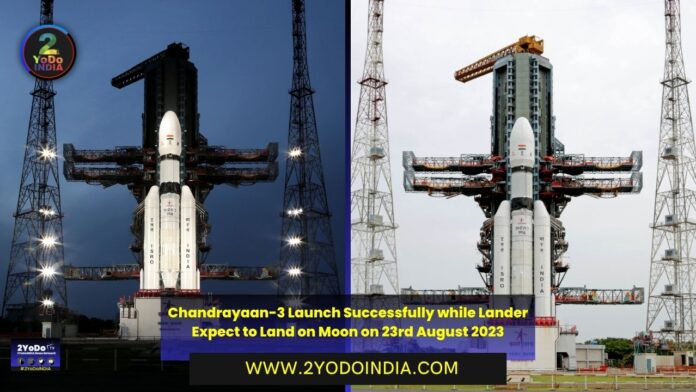Today the GSLV Mark 3 (LVM 3) heavy-lift launch vehicle lift off successfully from the Satish Dhawan Space Centre in Andhra Pradesh’s Sriharikota as per the schedule launch time. The journey from Earth to the moon for the spacecraft is estimate to take about a month and the landing is expected on 23rd August 2023.
After landing, it will operate for one lunar day, which is approximately 14 Earth days.
One day on the Moon is equal to 14 days on Earth.
Chandrayaan-3, India’s third lunar exploration mission, will make India the fourth country after US, China, and Russia, to land its spacecraft on the surface of the moon and demonstrate the country’s abilities for safe and soft landing on the lunar surface.
As Chandrayaan-3 is the ISRO’s follow-up attempt after the Chandrayaan-2 mission face challenges during its soft landing on the lunar surface in 2019 and was eventually deem to have fail its core mission objectives.
Chandrayaan-3 will be insert into the Lunar Transfer Trajectory after the orbit-raising maneuvers.
Covering a distance of over 300,000 km, it will reach the Moon in the coming weeks.
Scientific instruments onboard will study the Moon’s surface and enhance our knowledge.
Chandrayaan-3 is equip with a lander, a rover, and a propulsion module.
It weighs around 3,900 kilograms.
Chandrayaan-3 Landing Is Important Step for Exploration: ISRO Chief
— 2YoDoINDIA News Network (@2yodoindia) July 14, 2023
For more Details visit : https://t.co/oDCzPQw8K4
For more news visit : https://t.co/98KV4yIruC#2YoDoINDIA #Chandrayaan3 #Chandrayaan2 #Chandrayaan #MoonEarth #Space #ISROChief #SSomanath pic.twitter.com/IYr8tpiAAJ
Moon serves as a repository of the Earth’s past and a successful lunar mission by India will help enhance life on Earth and also enabling it to explore the rest of the solar system and beyond.
Todat (14th July, 2023) will always be etch in golden letters in the annals of India’s space sector history, said Prime Minister Narendra Modi, ahead of the launch of the much-awaited Chandrayaan-3, India’s third lunar mission.
Chandrayaan-2 was equally pathbreaking because data from the Orbiter associate with it detect the presence of chromium, manganese, and sodium for the first time through remote sensing.
The key scientific outcomes from Chandrayaan-2 include the first-ever global map for lunar sodium, enhancing knowledge on crater size distribution, unambiguous detection of lunar surface water ice with IIRS instrument, and many more.
Chandrayaan-3’s development phase commence in January 2020 with the launch plan sometime in 2021.
But, the Covid-19 pandemic brought an unforeseen delay to the mission’s progress.





